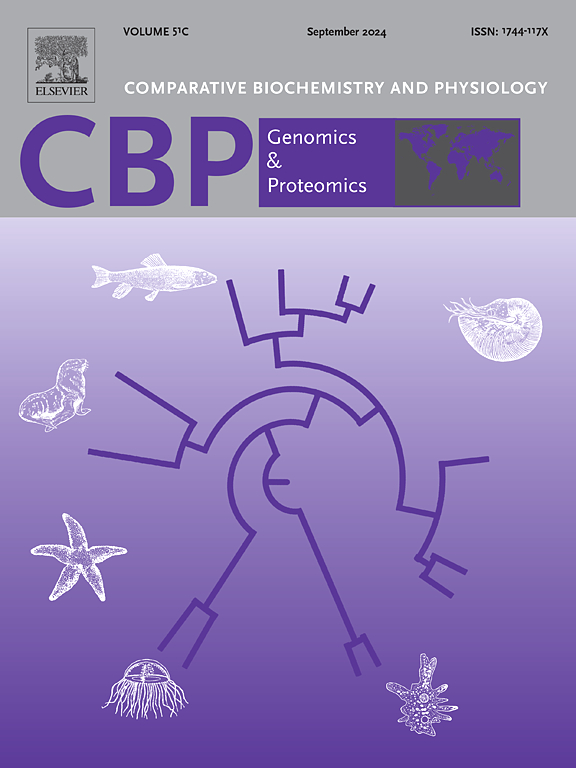The response mechanism of high pH and alkalinity interactive stress on immune system and energy metabolism pathway of Litopenaeus vannamei
IF 2.2
2区 生物学
Q4 BIOCHEMISTRY & MOLECULAR BIOLOGY
Comparative Biochemistry and Physiology D-Genomics & Proteomics
Pub Date : 2025-05-13
DOI:10.1016/j.cbd.2025.101531
引用次数: 0
Abstract
Litopenaeus vannamei is an important aquaculture species and faces complex stress challenges in saline-alkali water, such as high pH and alkalinity. In this study, the immune and metabolic responses of L.vannamei under acute interactive stress (pH 9.2, alkalinity 350 mg / L) were investigated by multi-omics analysis. The results showed that significant changes in antioxidant enzyme activity (e.g., increased SOD, decreased GSH-Px) and immune-related pathways (lysosomes, TGF-β, glutathione metabolism) were affected. Transcriptome analysis identified 1968 DEGs, which were mainly enriched in apoptosis, immune defense, and energy metabolism pathways. Metabolomics revealed the disorder of lipid, amino acid, and nucleotide metabolism, and key metabolites (such as arachidonic acid and sphingomyelin) were related to oxidative stress and membrane stability. Multi-omics integration showed that PI3K-AKT and TGF-β signaling pathways were coordinated and regulated under stress conditions. WGCNA analysis obtained a total of 19 co-expression modules. Among them, 13 hub genes related to saline-alkali stress were screened out in the turquoise and brown modules, and a transcriptional regulatory network was constructed. The expression patterns of five pairs of genes in four hot pathways under saline-alkali stress were verified. In summary, high pH and alkalinity interaction stress induces oxidative damage, disrupts metabolic homeostasis, and triggers adaptive responses through immune activation and energy redistribution. This study provides clues for exploring the molecular response mechanism of L. vannamei under saline-alkali stress and provides a theoretical basis for optimizing shrimp culture in saline-alkali waters.

高pH和高碱度交互胁迫对凡纳滨对虾免疫系统和能量代谢途径的响应机制
凡纳滨对虾(Litopenaeus vannamei)是一种重要的水产养殖物种,在高pH、高碱度等盐碱水环境中面临复杂的胁迫挑战。本研究采用多组学方法研究了凡纳梅在pH 9.2、碱度350 mg / L条件下的免疫和代谢反应。结果显示,抗氧化酶活性(如SOD升高、GSH-Px降低)和免疫相关途径(溶酶体、TGF-β、谷胱甘肽代谢)发生了显著变化。转录组分析鉴定出1968个DEGs,主要富集于细胞凋亡、免疫防御和能量代谢途径。代谢组学显示,脂质、氨基酸和核苷酸代谢紊乱,关键代谢物(如花生四烯酸和鞘磷脂)与氧化应激和膜稳定性有关。多组学整合表明,应激条件下PI3K-AKT和TGF-β信号通路受到协调和调控。WGCNA分析共获得19个共表达模块。其中,在绿松石和棕色模块中筛选出13个与盐碱胁迫相关的枢纽基因,构建了转录调控网络。验证了盐碱胁迫下5对基因在4条热通路上的表达模式。综上所述,高pH和高碱度相互作用胁迫诱导氧化损伤,破坏代谢稳态,并通过免疫激活和能量重新分配触发适应性反应。本研究为探索凡纳米对虾在盐碱胁迫下的分子响应机制提供了线索,并为盐碱水域对虾养殖优化提供了理论依据。
本文章由计算机程序翻译,如有差异,请以英文原文为准。
求助全文
约1分钟内获得全文
求助全文
来源期刊
CiteScore
5.10
自引率
3.30%
发文量
69
审稿时长
33 days
期刊介绍:
Comparative Biochemistry & Physiology (CBP) publishes papers in comparative, environmental and evolutionary physiology.
Part D: Genomics and Proteomics (CBPD), focuses on “omics” approaches to physiology, including comparative and functional genomics, metagenomics, transcriptomics, proteomics, metabolomics, and lipidomics. Most studies employ “omics” and/or system biology to test specific hypotheses about molecular and biochemical mechanisms underlying physiological responses to the environment. We encourage papers that address fundamental questions in comparative physiology and biochemistry rather than studies with a focus that is purely technical, methodological or descriptive in nature.

 求助内容:
求助内容: 应助结果提醒方式:
应助结果提醒方式:


